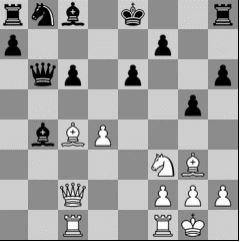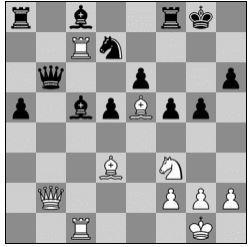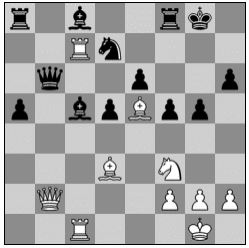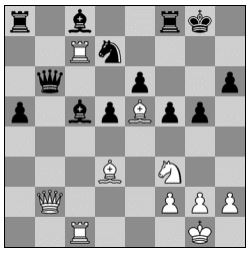Bernie Xu (1519)
Erik Brodsky (1751)
84th Massachusetts Open (5)
05.25.2015
QGD – Semi-Slav (D43)
1. d4 d5 2. c4 c6 3. Nf3 Nf6 4. Nc3 e6 5. Bg5 h6 6. Bh4 dxc4 7. e4 g5 8. Bg3 b5
A very topical line at the highest levels for at least the last decade.
9. a4
Quite rare, and perhaps for good reason. Heavy duty theory lines include 9. Be2, 9. Ne5, 9. h4, and 9. e5 which can also arise via the 5....dxc4 6. e4 b5 7.e5 h6 8.Bh4 g5 9.Bg3!? order.
9... Bb4?!
9... b4 should be the most critical test. Following 10. Na2:
- 10... Ba6!? looks like a good alternative to taking more material. 11. Ne5 (11. e5 Nd5µ 0-1 (25) Kamrukov, A - Krasnov,Y (2055), Novosibirsk 2008; 11. Be5 Nbd7µ 0-1 (25) Misovic,S (1945) - Hitter,G (2026), Busevec 2009) 11... Nbd7!? 12. Nxc6 (12. Nxc4 Bxc4 13. Bxc4 Nxe4; 12. Bxc4 Bxc4 13. Nxc4 Nxe4³) 12... Qb6 is good for Black
- 11. Be5 Nf6 12. Bxc4 Nbd7 13. O-O gave White some compensation in Cori Tello,D (2361)-Paikidze,N (2279), Puerto Madryn 2009 1-0 (48)
10. Qc2 Qa5?!
Looks risky, and usually not a great idea in this sort of position. If White gets castled quickly, axb5 will be a very unpleasant threat. 10... Nbd7 or 10... Bb7 both seem better.
11. Be2!?
Interesting, as it gives up more material for a large lead in development. However, 11. Nd2! defends everything, and prepares Be2 and 0-0, setting up axb5:
- 11... Bb7 12. Be2 (or 12. h4!?)
- 11… Nbd7 12. Be2 Bb7 13. O-O and now Qb6 is virtually forced. 14. e5 (14. Rfd1!?) 14... Nd5 15. Nde4 leaves White up a tempo in a sharp position, due to ...Qa5-b6
11... Nxe4 12. O-O Nxc3
12... Bxc3? 13. Qxe4 is a disaster: 13… Bxb2 14. Rab1 c3 15. Bxb8!? (15. Ne5 playing for a direct attack is probably even better.) 15... Rxb8 16. Qe5+- is an unusual forking tactic. 12... Nxg3 13. hxg3 also looks like a ton of compensation.
13. bxc3 Bxc3 14. Rac1
OK... so it's 3 full pawns, but it looks extremely dangerous for Black. Over the board, it's very difficult to navigate through even a few moves without landing in trouble. 14. Rad1!? could also be considered. Since White apparently doesn't mind giving up material, even 14. Ra3!? b4 15. Rxc3! bxc3 16. Ne5 could be tried. Looks pretty terrifying for Black, actually!
14... Bb4?
And black immediately goes wrong. 14... b4 15. Ne5 Qd8 (Black can't allow Nxc4-d6+ with the king still on e8) 16. Nxc4 O-O and now White should put a piece on d6, although it's tough to say which one is correct:
- 17. Nd6 Ba6 (17... Bxd4 18. Qe4 looks very dangerous) 18. Nxf7!? Rxf7 19. Qg6+ Rg7 20. Qxe6+ Kh7 21. Qe4+ Kg8 is a possible line ending in a pertpetual.
- 17. Bd6 Ba6? (17... Re8 18. Bh5! threatens the decisive Bxf7+ Qd7 19. Ne5+-) 18. Bxf8 Qxf8 19. Ne5 Bxd4∞ and Black should be reasonably happy here.
15. axb5 Qxb5 16. Bxc4 Qb6

17. Be5
Not bad, but 17. d5! blows the position apart with decisive effect: 17… exd5 (17... cxd5 18. Bxd5 Bb7 19. Bxb7 Qxb7 20. Qc8+ wins everything) 18. Bxd5 and the black king is stuck in the center with no defense. Of course if 18… O-O, 19. Qg6+ follows.
17... O-O 18. Bd3?
Threatens mate, but definitely not incisive enough. Both 18. Bf6!? with the idea of 18… Nd7? 19. Bxe6 and the ultra-direct 18. h4 seem more to the point: If 18… g4 19. Nh2 f5 20. Nxg4, everything is collapsing around the black king.
18... f5
This looks safest. 18... f6 19. Bh7+ (19. Ba6!? is a very creative, silicon idea, which looks super strong after 19… f5 20. Bxc8 Rxc8 21. d5!) 19... Kh8 20. Qg6 fxe5 21. Qxh6 looks crushing, but maybe it's not so clear: 21… Qc7 22. Nxg5 (22. Nxe5?? Qxh7 23. Ng6+ Kg8-+ as the bishop defends f8; 22. Be4+ Kg8) 22... Qg7)
19. Rb1 a5 20. Qb2?! Qa7
20... Nd7 followed by ...Ba6 starts to dry up White's compensation.
21. d5?
Looks like a wild swing... 21. Rfc1 still gives reasonable compensation
21... cxd5?!
Seems illogical. 21... exd5 keeps the c-file closed, and it's hard to say what the followup is. If 22. Nd4 c5µ with the black queen always having access to the kingside for defensive purposes.
22. Rfc1 Nd7?
Now the black queen gets a bit cut off (see the comment to the previous note). 22... Qe7 23. Rc7 Nd7 and anything is possible: 23... Bd7 24. Nd4°
23. Rc7 Qb6 24. Rbc1 Bc5

Hard to suggest something here. 24... Nxe5 25. Qxe5 Rf7 26. Rxf7 Kxf7 27. Rc7+ Be7 28. Nd4 offers White too many threats.
25. Bb5??
Missing 25. R1xc5! Qxb2 26. Bxb2 winning at least a piece, as 26… Nxc5 27. Rg7+ Kh8 28. Rxg5+ Kh7 29. Rg7+ Kh8 30. Nh4 has mate coming.
25... Bxf2+!
The best chance
26. Kh1
26. Qxf2 Qxb5 27. Bd4 still gives Black a lot of problems. Qe3 will not only threaten e6, but Nxg5 as well: 27… Qb4 28. Qe3 Qe7 looks forced, and 29. Bc5 wins material without slowing the attack down.
26... g4
26... Rb8 is forced, and maybe then black is defending: 27. Bh8 e5 (27... Rf7 28. Rxc8+) 28. Bxe5 Qxb5 29. Qxf2 Nxe5 30. Nxe5 Qb2 31. R1c6 Qxf2 32. Rg6+ =
27. Bxd7??
27. R1c6! Qe3 28. Rxe6 breaks through decisively: 28… gxf3 29. Rg6+ Kf7 30. Rg7+ Ke8 (30... Ke6 31. Rc6#) 31. Rxc8+ Rxc8 32. Bxd7+ Kd8 33. Bf6+ Kc7 34. Bxc8+ and many mating ideas loom.
27... Qxb2 28. Bxb2 Bxd7 29. Ne5 Be8?
29... Be3! 30. Rxd7 (30. Re1 Rfb8) 30... Bxc1 31. Bxc1 Rfb8 when the 2 pieces are no match for the rook and mass of pawns, especially the guy on the outside. 29... Rab8 should also be winning.
30. Nxg4!
White immediately capitalizes on his chance.
30... fxg4 31. Rg7+ Kh8 32. Rcc7
Threatens mate in 2, and looks winning except for:
32... Bd4!

A great resource! Was this really foreseen back at move 29?
33. Bxd4?
Tough to keep one's bearings (and objectivity) here, but taking the perpetual with 33. Rh7+ Kg8 34. Rcg7+ Bxg7 35. Rxg7+ Kh8 36. Rxg4+ was necessary.
33... Rf1+ 34. Bg1 Rf7?
34... Rb8 looks logical, and (maybe!) winning for Black: 35. Rh7+ Kg8 36. Rcg7+ (36. Rhg7+ Kf8 37. Rh7 Rf7) 36... Kf8 37. Ra7 Rf7 (37... Bf7 38. Raxf7+ Rxf7 39. Rh8+ Ke7 40. Rxb8) 38. Rh8+ Kg7 39. Bd4+ Kg6 40. Rg8+ Kh5! and now (40... Kf5 41. Rxf7+) 41. Rxf7? isn't check. so (41. h3) 41... Rb1+ 42. Bg1 Bxf7 wins easily; 34... e5! is safer and best, shutting down any funny business on the long, dark squared diagonal. 35. Rh7+ Kg8 36. Rhg7+ Kf8 37. Rh7 Rf7 is clearly winning.
35. Rcxf7 Bxf7 36. Bd4 Rb8?
Now Black is the one who should be taking the draw with 36... e5 37. Bxe5 Re8 38. Rg5+ Kh7 (38... Rxe5 39. Rxe5 Kg7 isn't a legitimate winning idea, as 40. Re7 followed by Ra7 only gives White chances) 39. Rg7+ Kh8 40. Rg5+ is again a draw.
37. Rxg4+ Kh7 38. Rg7+ Kh8 39. Rxf7+ Kg8 40. Rg7+ Kf8 41. h3
41. g3! is better 41... Rb4 42. Bf6 gives White good winning chances.
41... Rb4! 42. Rg4
42. Bf6 Rf4. This is the big difference between 41. g3 and 41. h3. 43. Be5 Re4 gives Black an unusual "perp" by menacing the bishop on all squares of the diagonal.
42... Kf7 43. Rf4+?!
43. g3± or 43. Kg1± seem more productive, with White retaining good winning chances.
43... Kg6 44. Rg4+? Kf5
The last few moves just allowed Black to activate his king "for free".
45. Rh4 e5
45... a4 46. g4+ Kg6 47. Bc5 Rb3 48. Bf8 should also be equal.
46. g4+ Kf4 47. Bc3 Rb3 48. Bxa5 Kg3
48... Kf3! imediately forces a draw, as White has no way to escape the checks on b1 and b2.
49. Be1+ Kf3 50. Rxh6 Rb1 51. Rf6+ Ke3!
51... Ke2? isn't good as 52. g5 Rxe1+ 53. Kg2 Ra1 54. g6 Ra8 55. h4 d4 56. h5 d3 57. g7 d2 (57... Rg8 58. h6) 58. Rd6 wins.
52. Rf1 Ke2 53. Kg2 d4?
Black has to go for the queen ending after 53... Rxe1 54. Rxe1+ Kxe1 55. g5 d4 56. g6 d3 57. g7 d2 58. g8Q d1Q 59. Qg3+ Kd2 (59... Ke2?? 60. Qxe5+ Kd3 61. Qd5+ Kc2 62. Qxd1+) 60. Qxe5 Qc2!= which is a tablebase draw, but there are of course practical chances for White.
54. Rf2+! Ke3
Of course the bishop is untouchable: 54... Kxe1 55. Rf1+ Kd2 56. Rxb1
55. Bd2+
55. Kf1 seems a little safer, as the black king is cut off from the pawns, and the d2 square will always be under lock and key: 55... d3 56. g5 e4 57. g6 Rb7 58. h4+-
55... Kd3 56. g5 e4 57. g6?
57. Bf4! e3 58. Rf1 Rb2+ (58... Rxf1 59. Kxf1 Kd2 60. g6 Kd1 61. Bg3) 59. Kf3 still wins.
57... Rb6
57... e3 58. Bxe3 dxe3 59. Rf3 (59. g7?? exf2 60. Kxf2 Rb8 is unfortunate) 59... Rb2+=
58. Kf1 e3 59. Bxe3
59. g7 Rb1+ 60. Kg2 exf2 61. Kxf2 Rb8 62. Bf4=
59... dxe3

60. Rg2??
OH NO!!! Definitely not a good time to follow the rule, "Rooks belong behind passed pawns!" A draw was still available via 60. Rf7 Rb1+ (60... Rxg6 61. Rd7+ Ke4 62. Re7+ Kf3 63. Rf7+=) 61. Kg2 e2 62. Rd7+ Kc4! (62... Kc3 63. Re7 e1Q 64. Rxe1 Rxe1 65. g7 Re8 66. Kf3 Kd4 67. Kf4 and white draws by a hair) 63. g7 (63. Re7?? now loses, as the black king position has been improved by one square 63... e1Q 64. Rxe1 Rxe1 65. g7 Re8-+) 63... Rg1+ (63... e1Q?? 64. g8Q+ and black will get mated) 64. Kxg1 e1Q+ 65. Kg2, provided White doesn't drop his rook somehow.
60... Rb1#
Despite the very unfortunate ending, a truly amazing battle, showing great fighting spirit from both sides.
0-1
|